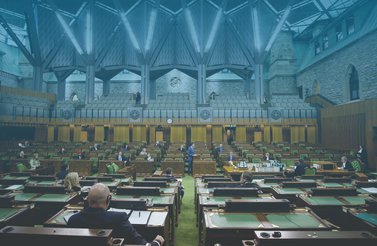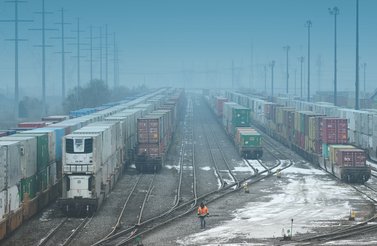OVID-19 is a global public health crisis, and the inevitable corollary impact is an economic crisis. In addition to causing a steep drop in economic output, the pandemic has exposed risks inherent to how companies operate their supply chains. More specifically, as businesses adapt to the changing economic landscape caused by the virus, the balance between supply chain resiliency and efficiency has come into focus.
Until the COVID-19 pandemic started, efficiency meant economies of scale, just-in-time production and minimal warehousing costs. In turn, the shift to resiliency has led to a focus on withstanding supplier and distribution disruptions. However, discussions about increasing supply chain resiliency often overlook the reality that in a market economy, the government does not own the supply chain. Instead, it sets the constraints and incentives for private sector behaviour.
Although national security has featured infrequently in the discussion around supply chains and what must change in response to COVID-19, economic resiliency and national security work in tandem. They are mutually reinforcing. Economic resiliency is underpinned by national security, and national security is paid for by economic resiliency.
The Current Economic and Security Environment
To set the context, it is important to first understand the challenges exposed by COVID-19.
Work by Statistics Canada and the Canadian Chamber of Commerce through the Canadian Survey on Business Conditions found widespread COVID-19-related disruptions to supply chains. One key finding was that only 16.8 percent of companies reported no disruption to their supply chains. Additionally, just over half of the respondents reported an inability to move goods because of disrupted supply chains.
The government-mandated shutdowns have created a wide range of issues for businesses. In addition to shutdowns causing obvious backlogs for manufacturing operations, there have been less apparent problems: backlogs at distributors’ warehouses due to companies being closed and unable to receive their merchandise; cargo container shortages causing bottlenecks for companies that need the containers for outbound shipping; and closures of third-party service providers, leaving some businesses unable to maintain critical back-office functions.
Domestic challenges are compounded by those at the global level. According to Global Trade Alert, 27 jurisdictions have reported 40 export restrictions on agriculture and agri-food products, and 89 jurisdictions have recorded 156 export restrictions on medical supplies since the beginning of 2020. Companies have also seen the collapse of available air cargo capacity because the steep drop in the number of passenger flights means less space to move goods. This reduction is a huge problem, since air cargo delivers 35 percent of the value of global trade, according to the International Air Transport Association.
These domestic and international developments have each disrupted economic productivity. In the case of export controls on medical supplies, they have also created risks to Canadians’ health. The most well-publicized example was US export restrictions on N95 masks, compounded by temporary export controls in the European Union, both of which reduced available supplies of personal protective equipment for Canadian businesses. Another notable example was the Indian government’s restrictions on more than two dozen active pharmaceutical ingredients. These constraints on trade were lifted after a relatively short period of time, but prolonged enforcement could have caused drug shortages in Canada.
Another major piece of COVID-19’s economic and national security impact is the accelerated decoupling of the US-China economic relationship that was well under way before the pandemic. However, concern about how China responded to the disease, and the growing bipartisan US consensus on the need to take a harder line with Beijing have increased pressure on Canada to align with its American allies. Drifting from the United States — or even appearing to do so — risks excluding Canada from sensitive supply chains and from being a trusted voice in Washington. Although attempting to see through the fog of diplomacy is always challenging, it was interesting that Canada did not participate in a May 11 US-hosted call on COVID-19 that included Australia, Brazil, India, Israel, Japan and South Korea. The official readouts from the US State Department and the Ministry of Foreign Affairs of Japan suggest China and COVID-19 were a key part of the agenda.
Framework for Setting Priorities
The next element in increasing Canada's supply chain resiliency is to establish broad criteria for ranking the importance of particular sectors. Doing so is easier said than done. As we saw from the shutdowns over the course of March 2020, provinces diverged widely in how they defined essential businesses. The federal government did not assert itself, instead only publishing non-binding guidance. The net effect of this regulatory incoherence was further disruptions for companies that operate in more than one province or territory. Sometimes an activity was allowed in one province but not in another. In the case of Quebec, truck cargo shipments into the province frequently proved difficult.
Another consideration is that supply chains include both goods and services. While physical products attract the most attention, services are equally important. This category includes production enablers such as financial services but also back-end transportation logistics and after-sales servicing, as well as front-end engineering and design. These intellectual property (IP)- and data-intensive aspects are critical for Canadian business competitiveness. For example, having accurate data can make Canadian agri-food producers more competitive. Because crops require appropriate levels of soil moisture to ensure they are neither over- nor underwatered, deploying soil sensors enables widespread data collection to make producers more efficient in allocating inputs. Another example could be the design of autonomous vehicles, which require significant technological investment to ensure the cars can operate safely on roads. Without this upstream part of the supply chain, it is much more difficult to control what happens downstream
Economic resiliency is underpinned by national security, and national security is paid for by economic resiliency.
While it may be tempting to make a sharp distinction between the so-called old economy and the new economy, the dividing line is quite blurry. In cases such as the agricultural and automotive sectors mentioned earlier, the knowledge-intensive parts of the supply chain are critical to the efficiency of the rest of the chain. They are linked in this sense. However, the knowledge-intensive components require different policy tools. For example, how does the government encourage the creation of IP and ensure its protection? Given the potential need of companies to outsource aspects of the development of proprietary knowledge, data governance rules might constrain their ability to share information with third-party partners. Another issue is how regulatory regimes affect the deployment of technology in new markets and enable businesses to have access to innovative products.
Another part of the equation is that supply chain resiliency is not simply a matter of building capacity to produce everything within Canada. Doing so is neither possible nor desirable. Take the example of medical ventilators. According to Medtronic, one model of its ventilators requires 1,500 parts, which currently come from 100 suppliers spread across 14 countries. It would be difficult to create the conditions for companies to profitably produce that volume of components to supply a comparatively small Canadian market.
It is also important to remember that Canada relies on exports for its economic security. A global beggar-thy-neighbour approach would damage large segments of the economy that depend on access to foreign markets, including agriculture and natural resources.
Using supply chain policies to achieve economic resiliency and national security should be benchmarked against several criteria. First, federal and provincial governments need to assess whether the goods or services are critical to the health and well-being of Canadians, since public safety and security help enable economic activity. Second, they need to determine whether the good or service currently comes from a concentrated or unreliable source. Third, they must ask whether the good or service is a critical component or is essential to global supply chains that support Canadian economic prosperity. Fourth, they need to decide whether moving the good or service offshore or letting it fall under the control of a hostile power creates a critical challenge.
The list of sectors meeting these criteria is daunting; it includes everything from specialized engineering services that support functioning infrastructure, to manufacturing of medical equipment and supplies, to financial services required for business transactions, to mining for rare earth minerals that come from only a handful of sources.
Tools to Ensure Economic Resiliency and National Security
Despite this broad list of critical sectors, the government has an extensive range of instruments to elicit outcomes it considers to be in the national interest.
One bucket of tools includes domestic policy levers that could provide greater incentives to produce in Canada. Near the top of the list are tax and regulatory policies. Reshoring production makes for a good sound bite, but structural factors need to be addressed to reverse Canadian manufacturing decline, foremost among them making Canada’s tax and regulatory systems competitive. In a post-COVID-19 era where governments around the world will create substantial new incentives to generate domestic manufacturing, Canada needs a compelling narrative to attract capital.
Another domestic tool is procurement, which can stimulate demand for companies’ outputs. One way is to use negotiated contractual conditions to encourage local production, although these requirements would need to respect Canada’s trade obligations. One justification could be on the grounds of public health and safety; another is using procurement as a means to stimulate early-stage industries and technologies in areas critical to national security, which, in turn, can develop into global players. An example of past success was the development of the Canadarm.
The government can also deploy a number of measures with an international focus.
The Investment Canada Act gives the government wide latitude to deny foreign takeovers to support our economic and national security objectives. Although the legislation enumerates factors involved in the net benefit test, IP is absent from section 20 of the act. As others have already noted, a small alteration to include IP and data would provide a basis for ensuring that Canada holds on to its innovations. Amending the act would also send a powerful signal to the market about the priority Canada places on domestic research and development. This focus on IP complements security, since IP is one of the most valuable parts of the supply chain. Ensuring that cutting-edge technologies do not fall into hostile hands is critical for protecting national security. One way to ensure a congruence on security grounds would be to have an accompanying amendment to section 6 of the Guidelines on the National Security Review of Investments to ensure national security considerations encapsulate data and IP. While some might argue that the guidelines’ section 6(ii) on technology transfer and “know-how” provide sufficient grounds, a more explicit statement would ensure coverage of early-stage and intangible products whose supply chain applications are nascent.
However, prudence must not be a back door for protectionism. Ultimately, as a trade-dependent nation, Canada relies on foreign markets to generate income and source products not made here. How to ensure our products can get into foreign markets is no secret: Canada requires a rules-based trading system. We need to support institutions such as the World Trade Organization and leverage bilateral trade agreements. As noted above, we will likely see governments aggressively subsidizing manufacturing as their economies recover from the effects of the COVID-19 pandemic. To buttress our domestic policies designed to prevent the hollowing-out of our manufacturing sector, tackling trade-distorting industrial subsidies must be a key part of the trade agenda.
A major challenge is how to ensure the ability to source inputs when they are needed most. COVID-19 demonstrated how quickly export restrictions emerged, even in countries with whom Canada has trade agreements. One idea would be for Canada to explore “supply agreements” with our most trusted allies. This framework would, in effect, be a free trade agreement plus, using a positive list of products where parties would commit to never impose export restrictions on bilateral trade, even on national security or health grounds. These supply agreements would only ever be practical with a small subset of allied countries, such as Australia, Japan, New Zealand and the United Kingdom. Examples of products that could receive coverage might include medical supplies or critical security products.
From Theory to Action
The identification of the tools at the government’s disposal is the easiest part. The real work comes in the execution. As critical as the intersection of economic and national security will be for the government’s post-pandemic economic policies, it is not the only issue the government will consider in shaping its overall approach. However, there are four concrete ways to move ahead with this agenda.
The first is using the newly announced advisory bodies, the Industry Strategy Council and the Economic Strategy Tables 2.0. Rather than looking solely at traditional economic metrics, the advice provided should consider national security and resiliency where appropriate to reflect all aspects of the national interest.
A second key measure is the pressing need for a comprehensive review of Canada’s tax system, which last occurred with the Carter Commission in the 1960s. Ensuring our tax system reflects the twenty-first-century economy and Canada’s supply chain needs is critical. Businesses need a coherent and competitive regime to attract investment at different points along the supply chain.
The third step is a reinvigoration of regulatory reform to support supply chains. This includes both using the Regulatory Reconciliation and Cooperation Table established under the Canadian Free Trade Agreement and inserting the need to consider economic competitiveness into the mandates of Canadian regulators.
The last step is to review Canada’s international policy. The global landscape is rapidly evolving, and Canada needs to make foreign policy and trade policy work together, instead of operating as silos.
Conclusion
Economic security is necessary to pay for national security, and national security creates the conditions for economic security. Achieving both by building supply chain resiliency is complex and challenging because each company needs to have the incentive structures in place that work for its individual business model.
In the current global environment, no foreign leader wakes up wondering how to protect Canadian interests. Our leaders, however, don’t have that luxury. With crucial national security and our economic interests at stake, Canada needs to be both strategic and determined as we chart our course.



